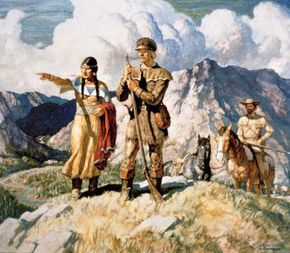Lewis and Clark's Journey
On Aug. 31, 1803, Lewis set out for St. Louis from Pittsburgh, Pa., with a crew of 13 men and one dog. On the way, they picked up Clark along the Ohio River. Pittsburgh, which was then known as the "Gateway to the West," was the perfect point of departure -- a bustling frontier town at the confluence of two rivers that was a large center of boat construction.
The time Lewis spent in Pittsburgh was filled with anxiety. The construction of the boat he had designed was delayed by six weeks, and he had trouble communicating with Clark. Adding to his tension was the news that weather conditions and falling water levels could delay his trip until the following spring. But Lewis hastened completion of the boat, and the group was able to set out on time. The expedition set up camp for the winter in the St. Louis area, where they awaited the legal transfer of the Louisiana Territory before they officially set out on May 21, 1804.
Advertisement
The size of the group traveling with the Corps of Discovery varied throughout the trip. Some members split off to explore other routes, some stayed with friendly tribes and some were picked up along the way. The official team, however, consisted of 33 people, 29 of whom were members of the Army. They earned between $5 and $8 per month for their services [source: Lewis and Clark Trail].
From St. Louis, the Corps of Discovery traveled northwest up the Missouri River to the Mandan Villages in what is now South Dakota. By following the Missouri they were able to forge through the Rocky Mountains, considered the most dangerous part of the trip because the Corps had no idea of its size. Once they crossed the Rockies, the group followed the Clearwater River to the Snake River, eventually coming to the Columbia River, which led them to their goal of the Pacific Ocean [source: PBS]. They had to drag their boats across the occasional valley, but for the most part they did follow a water route from east to west. However, it proved to be too dangerous and unmanageable for commercial endeavors.
After reaching the Pacific, the Corps set up Fort Clatsop, named for the tribe that inhabited that area west of the Columbia River in what is now Oregon. The group spent the winter there, started the return journey on March 23, 1806, and arrived back in St. Louis on Sept. 26 [source: National Geographic].
